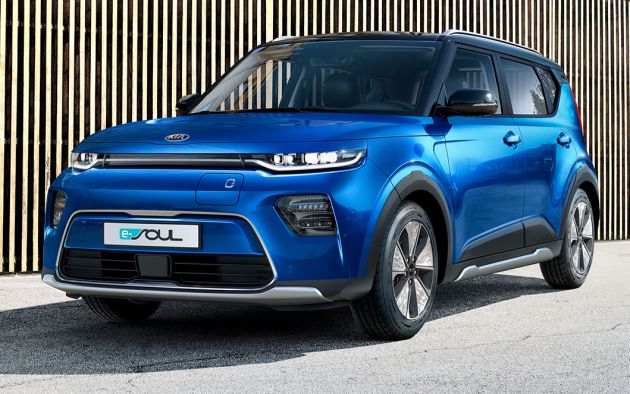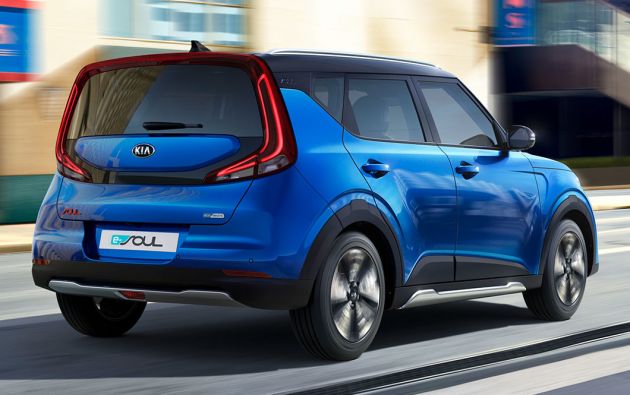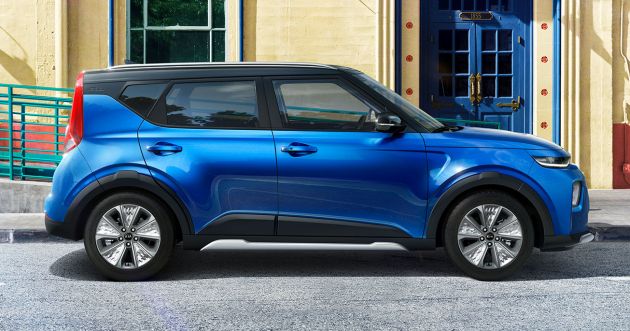Late last year, Kia introduced the third generation of its quirky, boxy Soul, including a new all-electric version. Now, the company has announced that the EV will make its way to Europe badged as the e-Soul, and has revealed a few extra details to get buyers in the Continent salivating.
One of those is range, which has been boosted from the previous model’s NEDC-rated 250 km to an impressive 452 km – and that’s on the new, more stringent Worldwide Harmonised Light Vehicle Test Procedure (WLTP). Kia says that the e-Soul’s energy consumption of 157 Wh per kilometre is 24% lower than Europe’s current bestselling EV, which we take to mean the Nissan Leaf.
Not only is it able to travel much further on a full charge, but it’s also much, much quicker. That’s because the motor now produces 204 PS and 395 Nm of torque – increases of a whopping 84% and 39% respectively – resulting in a zero-to-100 km/h time of just 7.6 seconds. Juicing the battery is a 64 kWh lithium-ion polymer battery that has a cell energy density of 250 Wh per kilogram, 25% higher than before.
Buyers can also specify a standard-range (read: cheaper) variant that produces 136 PS, has a range of 277 km through its 39.2 kWh battery and uses 145 Wh of electricity per kilometre. Both models are fitted with a built-in Combined Charging System (CCS) DC fast charger that will enable them to go from 20% to 80% charge in 42 minutes using a 100 kW DC fast charging station.
Efficiency is maximised through the use of a heat pump that scavenges heat from the coolant system, as well as an individual ventilation and air-conditioning system that can cool just the driver. It also has regenerative braking system with five modes (from zero to single-pedal driving), selectable via paddles on the steering wheel – it will even detect the car in front and adjust the braking level accordingly.
Like other new Soul models, the e-Soul switches from torsion beam rear suspension to a fully-independent multilink axle, which Kia says provides a more engaging, responsive and comfortable drive. The car is also fitted with a Drive Mode Select system with Normal, Eco, Eco+ and Sport modes, adjusting steering and electric motor settings depending on the driver’s intentions.
Kia’s US-market UVO Connect infotainment and telematics system makes its way to Europe for the first time on the e-Soul, featuring a 10.25-inch centre touchscreen and a built-in SIM card that enables live traffic information, weather forecasts, points of interest and on- and off-street parking information. It will also show charging station locations, charger availability and connection compatibility, a boon for EV drivers.
The system also supports Apple CarPlay and Android Auto, provides split-screen functionality and is linked to the UVO App. This allows drivers to check battery charging status as well as vehicle location, reports and diagnostic notifications, in addition to letting them remotely activate the climate control system, send route directions and activate charging – right through their smartphone.
The e-Soul is available with Kia’s Advanced Driver Assistance Systems (ADAS), including Forward Collision-avoidance Assist (FCA), Blind-spot Collision Warning (BCW), Blind-spot Collision-avoid Assist-Rear (BCA-R), Smart Cruise Control (SCC) with Stop and Go, Lane Keeping Assist (LKA), Driver Attention Warning (DAW) and High Beam Assist (HBA). Lane Follow Assist (LFA), which keeps the car centred in its own lane at speeds of up to 130 km/h, is also offered, as is Rear Cross-traffic Collision-avoidance Assist (RCCA).
Design-wise, the e-Soul retains the Soul’s distinctive styling, which consists of upper brow-like LED headlights, LED fog light strips, a wraparound windscreen and a blacked-out C-pillar garnish for that all-important “floating roof” look. Other details include an arrow-shaped character line on the front fenders, L-shaped tail lights and a body-coloured “island” nestled within the rear windscreen.
Unique e-Soul design cues include a solid panel instead of a “tiger nose” grille, along with 17-inch alloy wheels. Inside, you get the same “acoustic-inspired” dashboard, replete with integrated tweeters and a Sound Mood Lighting system. The latter – which can be seen through the three-dimensional pattern on the door cards – offers eight customisable colours and six themes, and pulses to the beat of whatever’s playing.
A range of single- and two-tone colour schemes are offered, which can be accented with contrast stitching via the optional Green, Gold and Red Packs. Also on the options list are wireless smartphone charging, heated front and rear seats, a premium Harman Kardon sound system and a head-up display.
Source: Read Full Article



